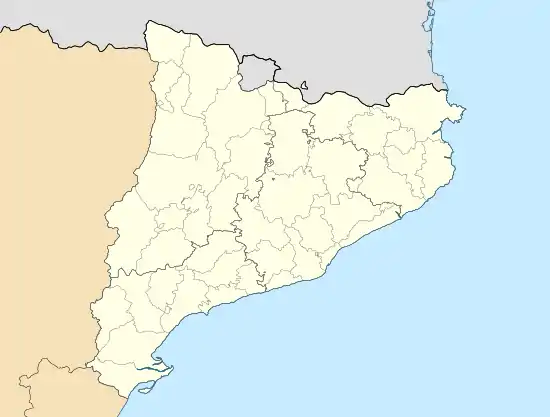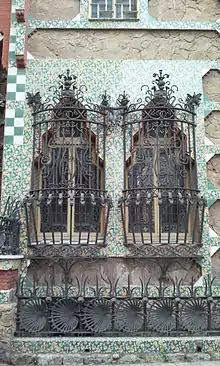Casa Vicens
Casa Vicens (Catalan pronunciation: [ˈkazə βiˈsɛns]) is a house in Barcelona, designed by Antoni Gaudí, now a museum. It is located in the neighbourhood of Gràcia on Carrer de les Carolines, 20-26. It is considered one of the first buildings of Art Nouveau and was the first house designed by Gaudí.
| UNESCO World Heritage Site | |
|---|---|
.jpg.webp) | |
| Location | Gràcia, Barcelona, Catalonia, Spain |
| Part of | Works of Antoni Gaudí |
| Criteria | Cultural: (i), (ii), (iv) |
| Reference | 320bis-004 |
| Inscription | 1984 (8th session) |
| Extensions | 2005 |
| Area | 0.12 ha (13,000 sq ft) |
| Buffer zone | 4.23 ha (455,000 sq ft) |
| Coordinates | 41°24′13″N 2°09′04″E |
 Location of Casa Vicens in Barcelona  Casa Vicens (Catalonia)  Casa Vicens (Spain) | |
_-_3.jpg.webp)
The style of Casa Vicens is a reflection of Neo-Mudéjar architecture, one of the popular styles that can be seen throughout Gaudí's architecture, including oriental and neoclassical as well. However, what was unique about Gaudí was that he mixed different styles together and incorporated a variety of different materials, such as iron, glass, ceramic tiles and concrete, many of which can be seen in this building. Gaudí broke away from tradition and created his new language of architecture, and Casa Vicens represents a new chapter in the history of Catalan architecture as well as the beginning of a successful career for Gaudí.
In 1883, Gaudí received the commission from Manuel Vicens i Montaner for the completion of a summer residence. In February 1883, Manuel Vicens requested permission from the City Council of Vila de Gràcia to build a summer house on Calle Sant Gervasi 26 (currently Carolines 20-26). A month earlier he had requested permission to demolish the house he had inherited from his mother, Rosa Montaner given the poor state of conservation of the same.
Although Mr. Manuel Vicens remains a quite unknown character, his will mentions his profession: brokerage and exchange, which would mean that he alleged his connection with ceramics and that he would be reinforced by the inventory of 1885 of the ceramic factory Pujol i Bausis that is conserved in the Municipal Archive of Esplugues de Llobregat, there is documented Mr. Manuel Vicens i Montaner, of Gracia, as a debtor of 1,440 pesetas.[1]
This early work exhibits several influences, most notably the Moorish (or Mudéjar) influence. Casa Vicens marks the first time Gaudí utilized an orientalist style, mixing together Hispano-Arabic inspiration. This was a style of architecture that completely breaks with the norm of the period. Not only does this house mark Gaudí's coming of age, being his first major work of architecture, but it also represents the flowering of Catalan modern architecture.[2]
History
Initial construction
The plans for construction (site, main floor, facade and section) date back to January 15, 1883. Gaudí was granted a construction permit on March 8 of the same year (Number 239-71; certificate 613). This is recorded in the files of Las Corts de Sarriá.[1] The house is constructed of undressed stone, rough red bricks, and colored ceramic tiles in both checkerboard and floral patterns.
At the time of this construction, Gaudí was just beginning his career. Gaudí graduated from the Provincial School of Architecture in Barcelona in 1878. Throughout his time in school and in the period shortly after, his work portrayed a rather Victorian style, similar to that of his predecessors; however, shortly after finishing school he began to develop his own style that was characterized by Neo-Mudéjar influence. Some characteristics of this style include the juxtaposition of geometric masses, the use of ceramic tiles, metalwork, and abstract brick ornamentation.[3]
Renovations
In 1899, Casa Vicens was acquired by Dr. Antonio Jover, a surgeon from Havana, Cuba who was the grandfather of the owners of the building prior to its sale to MoraBanc in 2014. In 1924, Jover moved into the house. Before that, it had only been used as a holiday home. During the time of his ownership the house was a private building and was not open to the public. However, the one day that visitors could enter was on 22 May for Saint Rita's day.[4]
In 1925, architect Juan Sierra de Martínez added on a new bay to the rear of the building, following the same style as Gaudí, and also significantly extended the size of the garden. He also modified the main floor entrances. With the widening of Carrer de las Carolinas, the access to the house had to be changed. The former entrance was converted into windows that open directly on to the street and can still be seen today.[5] These renovations were done with maximum respect for the original work, and Gaudí himself even approved these plans. During this time, he was busy constructing the Sagrada Família and was too busy to assist with the renovations for Casa Vicens. Martínez also built a cupola-topped chapel dedicated to Saint Rita at the angle furthest from the house. He continued this project until its completion date in 1926. Due to this work, Martínez won the prize for the best and most emblematic building of the city of Barcelona (Concurs annual d'edificis arístics) in 1927, awarded by the city council.[1]
A final restoration took place between the years 2001 and 2004. The aim of this restoration was to consolidate the facades and furnishings. This work was done under architect Ignacio Herrero Jover.[1]
Construction
Exterior
The roof of Casa Vicens is sloped on two sides and has four gables. A small path was built around the edge of the roof that allows for easy and accessible maintenance if necessary. A characteristic seen throughout Gaudí's work is that the ventilation conducts and chimneys are intricately decorated in similar styles as the facade, adding to and extending the artistic drama of the architecture.[5]
Layout

The house is divided into four levels: a basement, two floors for living and a loft. The original building was small and measured only 12 x 16 meters with two individual bays. A brick waterfall fountain was built as well. The basement is 302 meters2, the ground floor is 332 meters2 plus 22 meters2 of terrace, the first floor is 225 meters2 plus 79 meters2 of terrace, and the second floor is 272 meters2. The total area of the house is roughly 1266 meters2.[5]
On the ground floor, there is an extensive sitting-dining room, a small Turkish-style smoking room, and two additional rooms. This floor was slightly elevated to allow for better ventilation and improved lighting of the basement. The second floor was where the family's bedrooms were. A horseshoe-shaped stairway served as access to this floor. The third floor, or the attic, was where the servants lived. The horseshoe-shaped stairway also continued up to this floor. However, after the renovations in 1925 the location of the stairway that gave access to the bedrooms was changed. The basement, or bottom floor contained just enough space for a storage room, junk room and a kitchen. The basement received its light from an English-style courtyard.[5]
Artistic style


Casa Vicens was built using a variety of different materials and vibrant colors. This style was a key characteristic of modern architecture. Some key elements include bricks, tiles and iron. The architecture of the house itself was unique, however the combination of paintings, sculptures and the applied arts adds essential complements that are characteristic of the modern style of Gaudí.[1]
Neo-Mudéjar architecture is a type of Moorish revival architecture that Gaudí incorporated into Casa Vicens. This revival movement began in Madrid in the late 19th century, later spreading to other parts of the country. It is considered Spain's special mixture of Muslim-Christian design.[3] Some features of this ancient style such as horse-shoe arches, and abstract and vibrant facade ornamentation can be seen in Casa Vicens; the horse-shoe shaped staircase and the brick ornamentation on the front facade.[6] El Capricho (1833-1835) and the Güell Estate of the later 1880s are two other examples of Neo-Mudéjar style in Gaudí's architecture.
Interior
The dining room is the most decorated room in the house and incorporated many figures from nature, such as birds and vines. Gaudí used pressed cardboard to create three dimensional model figures of ivy, fruit and flowers for the interior of the building. The dome painting in the sitting room gives one the impression of looking through a glass dome, to the sky. The interior ceiling ornamentation is decorated with colorful plants and flowers.[7]
Exterior
The first two levels of the house, as seen from the front facade facing Carrer de les Carolines, are lined with horizontal roles of ceramic tiles decorated with French marigolds that can also be seen on the floors in the interior of the house. These marigolds grew on the grounds of the estate, are an example of how Gaudí derived much of inspiration from his love of nature. The cast iron railings with their plant motifs and iron palm leaves that form the gates to the house are other ways that Gaudí incorporated nature into his work. Plants that had to be destroyed for the construction of the building, such as the marigolds or the palm trees, were incorporated into the details of the building. Casa Milá, popularly known as La Pedrera, is another example of Gaudí modern architecture whose design based on the ocean with its curved edges and seaweed motifs is another example of nature serving as his inspiration.[8]
From the second floor up, these tiles switch to vertical and the floral pattern on them is replaced with green and white tiles. Elegant cherub like figures sit on the edge of the small balcony that faces the street.[5] He paid particular attention to each and every detail, such as creating ridged edges to the corners of the building to avoid the austere appearance of classical architecture.[9]
Museum
Casa Vicens was a private residence until 2014. After being purchased by MoraBanc, a major restoration was conducted and it was opened to the public as a museum in November 2017.[10]
References
- "CASA VICENS". www.casavicens.es. Retrieved 2015-12-12.
- Bernstein, Fred A. "The Restoration of Casa Vicens, Antoni Gaudí's Hidden Gem". Wall Street Journal. ISSN 0099-9660. Retrieved 2015-12-12.
- "Antoni Gaudi | Spanish architect". Encyclopædia Britannica. Retrieved 2015-12-15.
- "Casa Vicens - Another Gaudí building will open in Barcelona". Spain-Holiday.com. Retrieved 2015-12-12.
- "Antoni Gaudi Casa Vicens. Pictures of Barcelona, sagrada familia, la pedrera, park guell". www.gaudiclub.com. Retrieved 2015-12-12.
- Lapunzina, Alejandro (2005). Architecture of Spain. Greenwood. p. 172. ISBN 0313319634.
- "Casa Vicens, Gaudí's first work, is on sale! | Cultural Travel Guide". Cultural Travel Guide. Retrieved 2015-12-12.
- Hughes, Robert. "Great modern building: Robert Hughes on the Casa Mila". the Guardian. Retrieved 2015-12-12.
- "Casa Vicens". www.barcelonaturisme.com. Retrieved 2015-12-12.
- Codrea-Rado, Anna (16 November 2017). "Gaudí's First Completed House Opens to the Public". The New York Times.